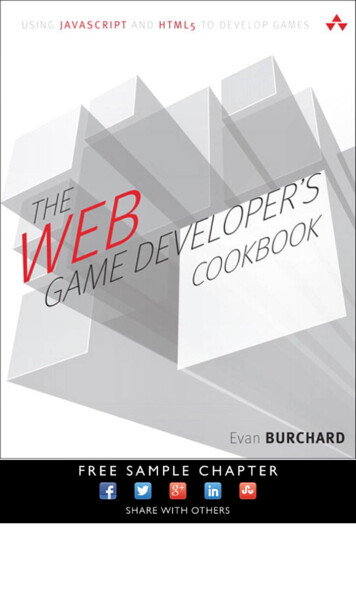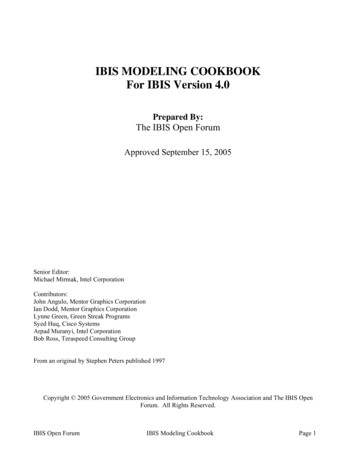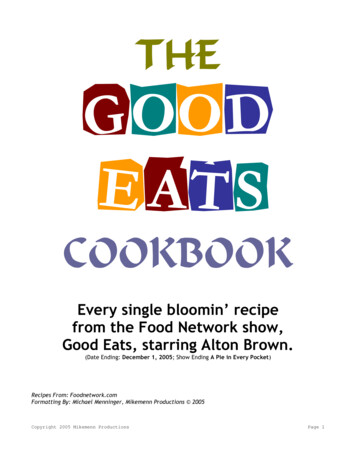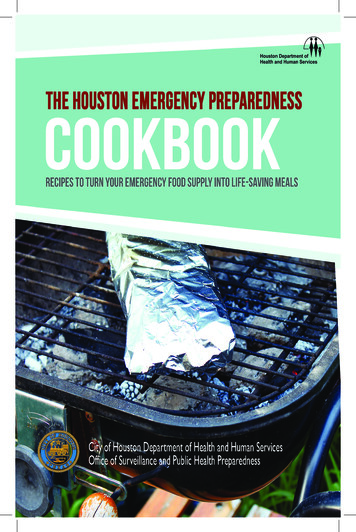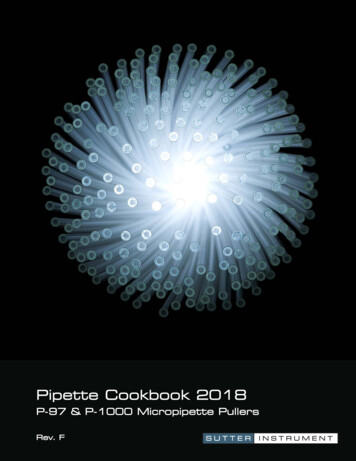
Transcription
IntroductionThe World in a CookbookOld cookbooks are captivating, and important too, leading us into theworld beyond the hearth. Without them, we could not have tasted our waydown the centuries to the dishes we embrace with such affection today. Thisbook began as a personal account of Mark’s and my collection of cookbooks andculinary images. It has gradually expanded to be a more general history of Europeanand early American cookbooks, though always seen from a personal viewpoint. We’vemade some surprising, illuminating connections between the way people lived andthe books they used.What is a cookbook? First, it is a collection of recipes—blueprints for a cook to recreate a dish. More specifically, according to cookbook bibliographer Henry Notaker,“A cookbook is a book with about two-thirds cookery instruction and . . . at least40–50 percent in recipe form.” 1 Surprisingly early, right from the start of the age ofprinting, a number of published books fit this description. The recipes in them may beembryonic, expressed in just a few lines, but their purpose of instruction is clear. Earlybooks with recipes covered far wider topics as well. Some sought to preserve the wisdomof the ancients, others offered advice on how to live a healthy life, and still others werepreoccupied with glorifying the banquets and feasts of a wealthy patron. In latercenturies, the voices of the authors come through more clearly and, indeed, a few suchbooks seem designed to showcase a personality rather than to instruct their readers.In writing about the evolution of cookbooks, I have separated chapters by century(rarely does an author overlap from one century to the next). The first chapter givesan outline of manuscript cookbooks before printing began. The opening date for themain text, that of the first printed cookbook in 1474, was easy to determine. The closeout of 1830 allows a little leeway for the geopolitical map drawn at the Congress ofVienna in 1815 to become firmly established, opening avenues for cookbooks to developthat were to remain clearly defined for almost a century.The first four printed cookbooks are known as incunabula, from the Latin word for“swaddling clothes,” which came to be used figuratively in nineteenth-century Englandfor the “childhood” of books, denoting those printed with moveable type before 1501.These early books were intended for the small audience of professionals who already1
I n t r od u c t io nknew how to cook, serving more as an exchange of ideas among the initiated than asinstruction manuals for the novice. Each was published in a different country andcompiled in a different language—Latin, French, German, or English. From thesebooks’ roots grew many genres. The sixteenth century brought cookbooks intendedfor the maître d’hôtel, or steward responsible for managing the household of a wealthynobleman or a prince of the church. Their authors gave space to organizing elaboratebanquets and planning menus; recipes were numerous but sometimes played a secondary role. Many aimed to enhance the reputation of their patrons or employers. A famousearly example is Banchetti composizioni di vivande e apparecchio generale (Banquets,Composition of Dishes and General Presentation, 1549), by Cristoforo di Messisbugo,steward at the famous court of Alfonso d’Este, duke of Ferrara. Around the sametime, a new prototype author appeared, the gentleman dilettante who enjoyed spending time in his kitchen, which he sometimes described as his laboratory. He discussedcooking, but within the broader context of distillation and other scientific or medicalexperiments. Some cookbook writers were also medical doctors, one example beingNostradamus, famous for his astrological predictions.Later books often explored cooking in combination with gardening. For example,Nicolas de Bonnefons’s Les delices de la campagne (The Pleasures of the Countryside,1654) includes excellent advice on how to cook garden produce. This book, togetherwith François Pierre de la Varenne’s Le cuisinier françois (The French Cook, 1651),strongly influenced the evolution of French classical cuisine. (As a good luck talisman,I kept a copy of Le cuisinier françois in my desk drawer when I opened La VarenneCooking School in Paris in 1975.) In England at the same time, books containinghousehold advice began to appear regularly. Many, such as Gervase Markham’s TheEnglish Hous-wife (1615), were primarily recipe books that provided extensive instructions for preparing food and drink, whereas others, such as Hannah Woolley’s TheGentlewomans Companion (1673), emphasized domestic conduct side by side with thepracticalities of cooking. In England from the seventeenth century on, many booksabout cooking were written by women for a readership of women. These books werethe seminal influence in the kitchens of the new nation of America.The words on the pages of old cookbooks reveal the cooks themselves. An almostmessianic fervor is characteristic of many great cooks, no matter what their nationality.In his Opera, Scappi addresses the young man who is his chosen successor: “I [took]you on as an apprentice and instruct[ed] you to the fullest of my ability in all thatmakes up the very best of my profession . . . making you a knowledgeable and astuteexpert in the art, so that . . . all my work and practical experience . . . should remainin you.” 2 This ideal of passing knowledge and practical expertise from generation togeneration likely stemmed from the apprenticeship structure common in many kitchens. In large establishments, cooks were ranked in a formal hierarchy, almost militaryin its precision—an organizational structure that was already developed in medievaltimes and remains firmly entrenched in today’s French professional kitchen. Such a2
I n t r od u c t io nabove Tacuinum sanitatis was a treatise on health and hygiene written in Arabic in the eleventhcentury by Ibn Butlân, a Christian physician born in Baghdad. When the book was first printed inLatin and then highly illustrated in the mid-1470s, it had immediate and long-lasting success. IbnButlân recommended a healthy life in harmony with nature, and the more than two hundredimages illuminate everyday life in medieval Italy. He talks of the seasons, food and drink, sleep,and the humors of body and mind. The original Tacuinum sanitatis was republished by fascist dictator Benito Mussolini in the twentieth century as part of a celebration of Italian heritage.3
I n t r od u c t io npattern was rarely found in England, and then usually in kitchens headed by a French-trained chef.English cooks took a different path, opting towrite household books on cooking at home for thefamily. The importance of a well-ordered homekitchen became a central topic in sixteenth-centuryEngland, first promoted by male authors and thenby women writers, who supplemented their recipeswith earnest advice for the novice and the poorlyeducated about menus and marketing, diet andmedicine, brewing and preserving, the managementof staff, and, inevitably, financial economy. The firstbooks were lively, venturing into a new world ofexciting ingredients and semiscientific discoveries.Later household works became more evangelical,useful no doubt but less warmhearted.Until the eighteenth century, writing cookbookswas a sideline. Then as now, few authors could expect to earn a living from books about cooking(hence Hannah Glasse’s second career as a dressmaker). Promotional ideas began as early as thesixteenth century, when an author’s portrait mightbe used as a frontispiece or titles might allude to afamous personage, as in The Queen’s Closet Opened(W. M., 1655). The acknowledgment of a patron,which had customarily appeared at the opening ofa cookbook, gradually gave way to a first-person preface with declamatory statementsabout the superiority of the author above all rivals. Publishers began to piggyback onthe reputation of a known author; for example, several texts were attributed to LaVarenne but almost certainly not written by him. Yet another approach was to solicitsubscribers as a guarantee of revenue before publication.If cookbooks did not enrich their authors’ purses, they did enhance their reputations. Chef François Menon wrote eight cookbooks in twenty years, not just to recordhis knowledge but also to ensure his professional success in the competitive environabove This early 1596 edition of Bartolomeo Scappi’s Opera, one of the most authoritative cookbooks of any century, was printed in Venice and contains nearly thirty woodcuts chronicling life inthe kitchens of the time. Here in the “cold room for working with milk,” cooks are pouring milkfrom a bag, whisking cream, and churning milk, probably to make butter. For cleanliness, all threeare wearing hats and aprons. Scappi is one of the first cooks to give complete cooking instructionsand include little asides on what to do in tricky moments and how to avoid disaster.4
I n t r od u c t io nment of mid-eighteenth-century Paris. With the establishment of restaurants andgentlemen’s clubs with fine dining rooms toward the end of the century, the chefs atthese elite venues began writing cookbooks for their patrons to take home, thus making the general public aware of what delicacies they might be missing. As a furthertwist, in the free and easy atmosphere of the early Napoleonic era, Grimod de la Reynière actually made a business of selling his personal journal, the Almanach des gourmands (perhaps benefiting from free dinners in the many restaurants he reviewed).In the four centuries after the first four printed cookbooks appeared, they movedfar beyond the role of simply documenting what happened in the kitchen. As we’llsee, they became textbooks, memoirs, dietary guides, gardening manuals, scientifictreatises, restaurant guides, and even political tracts, as well as leaders of fashion intothe future.About This BookOne of my roles has been testing and tasting recipes from each century for inclusionin this book. I’ve embarked with excitement on the pungent spiced sauces of medievaltimes, moving through the massive roasts and ragoûts of Louis XIV’s court to theelegance of eighteenth-century chilled and molded desserts. All the recipes are frombooks in our collection, and for each, I note the edition in which it appears—often afirst and usually an early edition. Within each chapter, recipes appear in the order oftheir date of printing. The style of the text is a whole other subject, as I explore in “TheWriting of a Recipe.” I have chosen the recipes both to represent their century and tobe accessible to today’s home cooks. Most are easy to prepare: Carême’s apple soufflé(1815), for example, calls for just three ingredients. A few are more challenging: Hannah Glasse’s Yorkshire Christmas Pie (1747) calls for five different birds, all boned andreshaped one inside another to bake inside a robust, freestanding wall of pastry crust.The modern recipes follow the old as closely as possible, though the early authors canbe difficult to interpret, their mind-set and methods of cooking being inevitably sofar from our own. In all of these dishes, I’ve looked for that little element of surprise,the opportunity to try an odd combination of ingredients or a new way of doing things.Each chapter in this book has two parts: text interspersed with boxes and a separatesection of recipes (translated into English as needed) with notes and renderings forthe modern kitchen. Boxes supplement the text and add a contemporary slant, covering subjects such as women in the kitchen and changes in the use of sugar. Spellingwas not standardized in Europe or the United States until recently. For this reason,the spellings of book titles and authors’ names in the text may not match what appearsin the images. Unless otherwise stated, the English translations in the text and recipesare by me or Mark. Where a published English translation is cited, quotations in thetext have come from this version. All images are from our cookbook and print collection, unless otherwise stated. Bon appétit!5
The Writingof a RecipeWhen I set out to explore the styleand content of recipe texts, I hadcertain expectations. I assumed thatat the dawn of printing, culinaryrecipes would be just a few lines,with rare measurement of ingredients and minimal directions. Thedetails that we look for today—precise quantities, with comprehensive,step-by-step instructions for thefinished dish—would be lacking. Ialso believed that as time advanced,recipes would become longer andmore precise, with authors providing more background details andflourishes. The reality is far morecomplex.The word recipe in all the Latinatelanguages shares the root recipere,meaning “to receive,” which whenconjugated in the imperative becomes recipe. Sources agree that“recipe” (or “receipt”) originallymeant a medicinal formula, withthe first English usage of the termappearing in the late fourteenthcentury. Recipes were a valuabletool, giving readers access to expertadvice on how to achieve consistentresults when making remedies forgout or headache, curative winesand herbal infusions, hair dye andskin cream, as well as tasty dishes.Doctors, alchemists, apothecaries,and cooks came to depend on theseformulas. One eleventh- or twelfthcentury poem addressed to Robertof Normandy, son of William theConqueror, sums up the benefits:“Every man may be a Graduate, andproceed [as] Doctor in the orderingof his owne body.”1Though rare, cooking instructionsexisted long before cooks developedthe notion of a “recipe”; they appearin manuscripts at least as far backas the fourth century—for example,in Apicius’s De re coquinaria (OnCooking). By the fourteenth century,6cooking instructions were still uncommon, though in his manuscriptcookbook Forme of Cury, King Richard II’s master cook precisely describes the ingredients of dishesand explains how to cook and servethem.2 Printing brought books ofrecipes into the kitchen, until at lastin the late sixteenth century, theterm recipe appeared in print todescribe a specifically culinarypreparation.3In investigating the progress ofprinted recipes, I decided to followthe dish called “white eating,” famous throughout Europe from medieval times to the present day under such names as blancmangein English, blancmanger in French,bianco mangiare in Italian, andmanjar blanco in Spanish. Chaucermentions “Blankmanger” in theprologue to his Canterbury Talesat the end of the fourteenth century.The dish itself changed radicallyover the centuries, but here I’m interested in the style and coherenceof the recipe explanation and itsvalue as an instructional sheet onthe page.The recipe for cibaria alba (whitefood) in De honesta voluptate et val etudine, the first printed cookbook,already had most of the key elements of a successful recipe.4 Everyrecipe has two basic components: adescription of the required ingredients, preferably in order of use, anda clear explanation of how to putthem together. Other details—ingredient measurements, informationon equipment, cooking times, serving suggestions—are secondary tothe essentials. The style in whichthese elements are presented varies markedly over time and fromIn this recipe for cibaria alba (white food) from the first printed cookbook, Dehonesta voluptate et valetudine, 1520 edition, Bartolomeo Sacchi (Platina) acknowledges his debt to his friend, the “immortal” cook Martino of Como. Theadvice to add a little water to emulsify the oil when grinding almonds, alongwith many other such tips, most certainly came from Martino rather than fromPlatina. The recipes also include quantities for many ingredients, though littlein the way of cooking instruction.
"A cookbook is a book with about two-thirds cookery instruction and . . . at least 40-50 percent in recipe form."1 Surprisingly early, right from the start of the age of printing, a number of published books fit this description. The recipes in them may be embryonic, expressed in just a few lines, but their purpose of instruction is clear.




